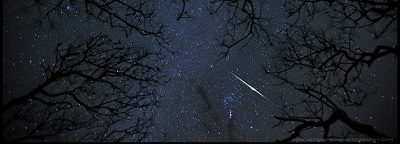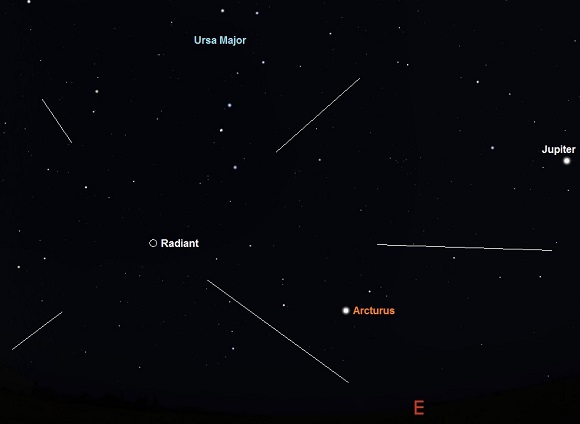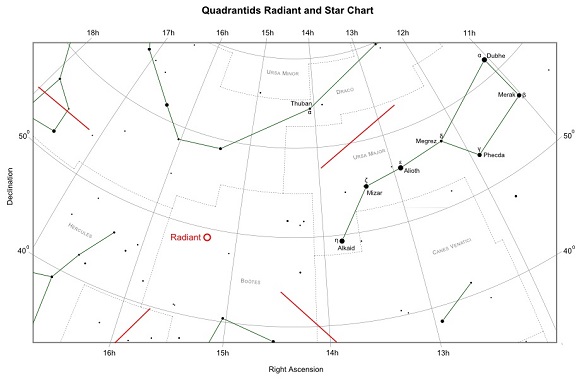The first annual meteor shower of the year to take place is always the January Quadrantids and it can be a good one with up to 100 meteors per hour visible at peak time. The high rate is comparable to other top showers such as the Perseids and the Geminids. However, unlike these well-observed events the Quadrantids are more elusive since the peak is short lived with a window of just a few hours. Consequently, it's no accident that they are challenging meteors and bagging a few of them makes a fine start to the new astronomical year.

Radiant and History
Meteor showers are named after the constellation (or nearby star) where the radiant is located but you will have difficulty figuring out the associated region for the Quadrantids; the reason being the constellation no longer exists. Today the Quadrantids radiant is located in northern Boötes not far from the tail of Ursa Major. When the shower was discovered by Adolphe Quetelet of the Brussels Observatory in the 1830s the radiant was in the now obsolete Quadrans Muralis, hence the name "The Quadrantids".
Quadrans Muralis was originally created by Joseph Jerome de Lalande in 1795. This constellation represents the mural quadrant, a wall mounted astronomical instrument used for measuring star positions. Although no longer recognized by the International Astronomical Union (IAU), Quadrans Muralis is one of the better known obsolete constellations due to its association with the shower.
Parent asteroid
Since the peak of the Quadrantids is exceedingly sharp compared to other major showers the stream of particles producing the shower must be relatively narrow. The recently discovered asteroid 2003 EH1 was proposed by Dutch astronomer and NASA senior research scientist Peter Jenniskens as the parent body of the Quadrantids. The asteroid is likely to be an extinct comet and may even be related to the comet C/1490 Y1 which was observed by Chinese, Japanese and Korean astronomers some 500 years ago.
Along with the Geminids the Quadrantids are the only major meteor showers not originating from a comet.
What to expect in 2016
The Quadrantids are active for a number of days with the peak activity window lasting for about 6 hours. In 2016, the shower is expected to be seen from January 1st to January 6th, maximum at 08:00 UT on January 4th. Prospects are good as the waning crescent Moon shouldn't interfere significantly. For those living in the United States, Canada and Greenland the shower radiant will be well placed above the northeastern horizon during peak time in the early hours of the morning. Further west in the sky is brilliant Jupiter, which at magnitude -2.2 is unmistakable. If predictions are correct, European observers don't have it quite as good as their American counterparts. Nevertheless the radiant rises as the evening progresses and the best time to look is after midnight again towards the northeastern part of the sky.
Most Quadrantid meteors are faint and medium to slow moving with some appearing yellow or bluish in colour. Occasionally a few bright meteors can be seen. As with all meteor showers the trails often streak across the sky a long distance from the actual radiant point. In many cases this can be thirty, forty or more degrees. It's therefore a good idea not to look directly at the radiant itself but scan a large area of sky surrounding it. If you have cloud free skies then the ellusive Quadrantids are certainly worth watching out for and keeping an account of.


Quadrantids Radiant and Star Chart - pdf format (credit:- freestarcharts)
Quadrantids 2016 Data Table
| Meteor shower Name | Quadrantids |
|---|---|
| Meteor shower Abbreviation | QUA |
| Radiant constellation | Boötes |
| Activity | January 1st -> January 6th |
| Peak Date | January 4th |
| RA (J2000) | 15hr 20m |
| DEC (J2000) | +49d |
| Speed (km/s) | 41 |
| ZHR | 120 (can vary between 60 and 200) |
| Rating | Bright |
| Parent body | 196256 (2003 EH1) |
| Notes | Peak intensity window is brief, sometimes lasting only a few hours. Together with the Geminids they are the only major meteor showers not originating from a comet. |
Asteroid 196256 (2003 EH1) Data Table (at epoch April 18th, 2013)
| Name | 196256 (2003 EH1) |
|---|---|
| Type | Asteroid (probably distinct comet) |
| Classification | Amor (NEO) |
| Discoverer | LONEOS (Lowell Obs, Anderson Mesa Station, Arizona, USA) |
| Discovery date | March 6, 2003 |
| Aphelion (AU) | 5.05608 |
| Perihelion (AU) | 1.18943 |
| Semi-major axis (AU) | 3.12276 |
| Eccentricity | 0.61911 |
| Orbital period (years) | 5.51855 |
| Inclination (degrees) | 70.8760 |
| Longitude of ascending node (degrees) | 282.961 |
| Last perihelion | March 12, 2014 |
| Next perihelion | September 17, 2019 |